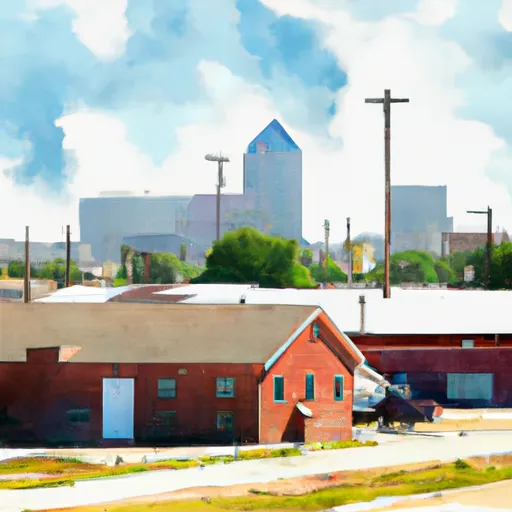-
 Snoflo Premium
Snoflo Premium
Get unlimited access to all our content
With no Ad interruptions! - Start Your Free Trial Login with existing account
Everman
Eden Index
Climate
9.7
•
Recreation
4.2
•
Community
2.2
•
Safeguard
5.9/10

Everman, Texas is a small city located in Tarrant County, Texas, with a population of around 6,000 people. The climate of Everman is humid subtropical, characterized by hot and humid summers and mild winters. Precipitation is evenly distributed throughout the year, with an average annual rainfall of 37 inches.
Everman is situated within the Trinity River watershed, which is a major source of water for the city. Hydrological constituents in this area include the Trinity River, which is used for drinking water, recreation, and industrial purposes.
Outdoor recreation opportunities in Everman include parks such as John P. Farr Park and Leo C. Burke Park, which offer amenities such as playgrounds, picnic areas, and walking trails. Additionally, residents and visitors can explore the nearby Chisholm Trail Parkway Trail, which is a multi-use trail that stretches for 27 miles through Tarrant and Johnson counties.
What is the Eden Index?
The Snoflo Eden Index serves as a comprehensive rating system for regions, evaluating their desirability through a holistic assessment of climate health, outdoor recreation opportunities, and natural disaster risk, acknowledging the profound impact of these factors on livability and well-being.
Climate Health Indicator (CHI): 9.7
Everman receives approximately
922mm of rain per year,
with humidity levels near 78%
and air temperatures averaging around
19°C.
Everman has a plant hardyness factor of
8, meaning
plants and agriculture in this region tend to thrive here all year round.
By considering the ideal temperature range, reliable water supplies, clean air, and stable seasonal rain or snowpacks, the Climate Health Indicator (CHI) underscores the significance of a healthy climate as the foundation for quality living.
A healthy climate is paramount for ensuring a high quality of life and livability in a region, fostering both physical well-being and environmental harmony. This can be characterized by ideal temperatures, reliable access to water supplies, clean air, and consistent seasonal rain or snowpacks.
Weather Forecast
Streamflow Conditions
Upper Trinity
Area Rivers
Upper Trinity
Snowpack Depths
Upper Trinity
Reservoir Storage Capacity
Upper Trinity
Groundwater Levels
Recreational Opportunity Index (ROI): 4.2
The Recreational Opportunity Index (ROI) recognizes the value of outdoor recreational options, such as parks, hiking trails, camping sites, and fishing spots, while acknowledging that climate plays a pivotal role in ensuring the comfort and consistency of these experiences.
Access to outdoor recreational opportunities, encompassing activities such as parks, hiking, camping, and fishing, is crucial for overall well-being, and the climate plays a pivotal role in enabling and enhancing these experiences, ensuring that individuals can engage in nature-based activities comfortably and consistently.
Camping Areas
| Campground | Campsites | Reservations | Toilets | Showers | Elevation |
|---|---|---|---|---|---|
| Healdton Municipal Lake | 57 | 900 ft | |||
| Cedar Grove - Lake Murray State Park | None | 764 ft | |||
| Field Trial Area - Lake Murray State Park | None | 799 ft | |||
| Johnson Branch - Roberts Lake State Park | 163 | 685 ft | |||
| Tipps Point - Lake Murray State Park | None | 755 ft | |||
| Rock Tower - Lake Murray State Park | None | 776 ft | |||
| Live Oak Ridge Park - Belton Lake | 45 | 624 ft | |||
| Dukes - Lake Murray State Park | None | 803 ft | |||
| Elephant Rock - Lake Murray State Park | None | 762 ft | |||
| Buzzards Roost - Lake Murray State Park | None | 764 ft |
Nearby Ski Areas
Catastrophe Safeguard Index (CSI):
The Catastrophe Safeguard Index (CSI) recognizes that natural disaster risk, encompassing floods, fires, hurricanes, and tornadoes, can drastically affect safety and the overall appeal of an area.
The level of natural disaster risk in a region significantly affects safety and the overall livability, with climate change amplifying these risks by potentially increasing the frequency and intensity of events like floods, fires, hurricanes, and tornadoes, thereby posing substantial challenges to community resilience and well-being.
Community Resilience Indicator (CRI): 2.2
The Community Resilience Indicator (CRI) recognizes that education, healthcare, and socioeconomics are crucial to the well-being of a region. The CRI acknowledges the profound impact of these elements on residents' overall quality of life. By evaluating educational resources, healthcare accessibility, and economic inclusivity, the index captures the essential aspects that contribute to a thriving community, fostering resident satisfaction, equity, and social cohesion.

